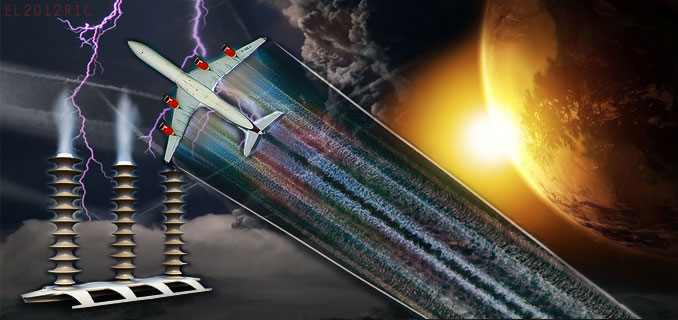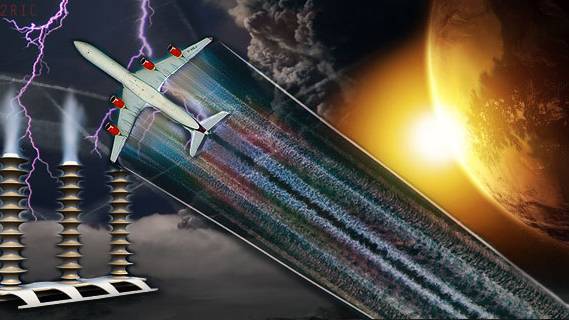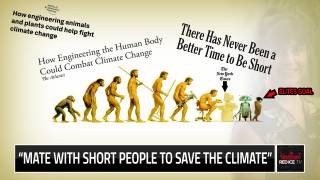"Sunshade" to fight climate change costed at $5 bln a year (Chemtrails?)
Source: in.reuters.com

Planes or airships could carry sun-dimming materials high into the atmosphere for an affordable price tag of below $5 billion a year as a way to slow climate change, a study indicated on Friday.
Guns, rockets or a pipeline into the stratosphere would be more expensive but generally far cheaper than policies to cut world greenhouse gas emissions, estimated to cost between $200 billion and $2 trillion a year by 2030.
Transporting a million tonnes of particles to at least 18 km (11 miles) above the Earth every year to form a sunshade is "both feasible and affordable", U.S. scientists concluded in the journal Environmental Research Letters.
The strategy, called "solar radiation management", broadly imitates a volcanic eruption. The 1991 eruption of Mount Pinatubo in the Philippines, for instance, blasted out a haze of sun-reflecting particles that slightly cooled the planet.
The authors did not examine whether such "geo-engineering" of the planet was a good idea. Other studies show it might have unwanted side effects, such as changing rainfall patterns.
"One attribute of solar radiation management is that it is quite inexpensive," co-author Professor Jay Apt of Carnegie Mellon University in Pittsburgh told Reuters.
"That doesn’t mean it’s the preferred strategy."
PLANES, AIRSHIPS
New aircraft, specially adapted to high altitudes, would probably be the cheapest delivery system with a price tag of $1 to $2 billion a year, they said. A new hybrid airship could be affordable but might be unstable at high altitudes.
A 20 km (12 mile)-long "space elevator" pipe hanging from a helium-filled platform was possible in theory but highly uncertain. Giant guns or rockets would be much more costly.
Some experts favour geo-engineering as a quick fix when governments are far from a deal to slow climate change that is expected to cause more heatwaves, floods and rising sea levels.
Senior officials are meeting in Bangkok this week for a new round of U.N. talks, aiming to agree a deal in 2015. Global greenhouse gas emissions have continued to rise, with China, the United States and the European Union the top emitters.
Dimming sunlight would not, for instance, slow the build-up of carbon dioxide in the atmosphere, which is making the oceans more acidic and undermining the ability of creatures such as mussels or lobsters to build their protective shells.
Co-author David Keith at Harvard University said there were serious risks in trying to dim the sun’s rays. But he said it might also "increase agricultural production by limiting impacts of climate change such as heat stress."
Independent scientists were also cautious.
"Research into climate engineering, including cost, is vitally important," said Matt Watson, a lecturer in Natural Hazards at Bristol University. "However, we must not get drawn into discussion where economics becomes the key driver."
Apt said temperatures could jump sharply under suddenly clear skies if society spewed sulphur into the stratosphere for years but then halted, judging that disadvantages outweighed the benefits.
"Abrupt stopping of the delivery of particles to the stratosphere would cause very rapid climate changes," he said.
Article from: reuters.com
Advancing the International Governance of Geoengineering
"What is the SRMGI?
The Solar Radiation Management Research Governance Initiative (SRMGI) was launched in March 2010 in response to the 2009 Royal Society report Geoengineering the climate. The report concluded that geoengineering is not an alternative to reducing greenhouse gas emissions. However, it may be the only option to reduce temperatures quickly in the event of a climate emergency.
The convening partners of the SRMGI are the Royal Society, TWAS, the academy of sciences for the developing world (TWAS) and Environmental Defense Fund (EDF).
The Solar Radiation Management Governance Initiative (SRMGI) is a partnership between the Royal Society and the Academy of Sciences for the Developing World (TWAS) and Environmental Defense Fund (EDF).
The project report, launched on 1 December 2011, reviews the progress made by the Initiative to date, covering the international SRMGI conference held in March 2011. It reviews the different perspectives and governance possibilities, without picking winners, in order to open up discussion of the complex issues raised by solar geoengineering.
The initiative aims to ensure that any geoengineering research that goes ahead – inside or outside the laboratory - is conducted in a manner that is responsible, transparent and environmentally sound.
Proposed geoengineering techniques that reflect the sun’s light and heat back into space may offer valuable opportunities to reduce global warming, and could do so quite rapidly, but their impacts could also affect rainfall, regional weather patterns and ocean currents. These impacts would not be restricted by national boundaries, so actions in one country could have highly significant effects in another, for example by changing rainfall and so affecting agriculture and water supply.
The Initiative has engaged with a variety of organisations from across the globe in order to foster an open international dialogue on how research should be governed. Participants include NGOs concerned with natural and social science, governance, legal issues, environment and development, plus industry and civil society organisations. This has ensured that evidence and opinion has been sought from a wide range of stakeholders with appropriate expertise. It is hoped that the international links developed by SRMGI – an important dimension of the project – will help promote cooperation on research governance in the future.
Tune into Red Ice Radio:
Michael Murphy - What in the World are They Spraying?
Peter Taylor - The Corporatization of the Environmental Movement
Rosa Koire - Hour 1 - Behind the Green Mask: U.N. Agenda 21
James Follett - The Church of Global Warming
Freeman - Space War, the Norway Spiral, CARE, CERN, HAARP & EISCAT
Sofia Smallstorm - Chemtrails, Nanotechnology & The Artificial Environment
Scott Stevens - Weather Wars, Chemtrails, Gulf Oil Spill & Environmental Destruction
Andrew Johnson - Chemtrails, Weather Modification & Climate Change
Freeman - Space War, the Norway Spiral, CARE, CERN, HAARP & EISCAT
H.P. Albarelli Jr. - Germ Warfare, CIA, LSD and the Murder of Dr. Frank Olson
Jerry E. Smith - Weather Warfare






















